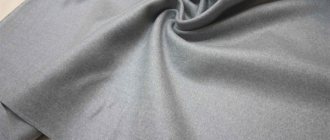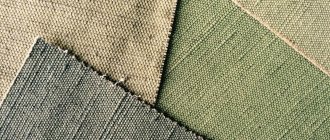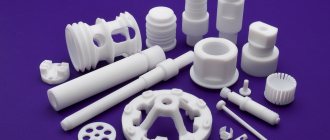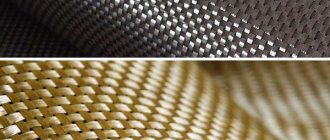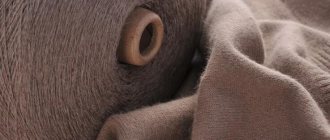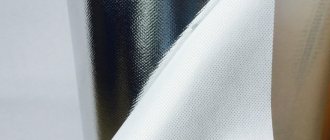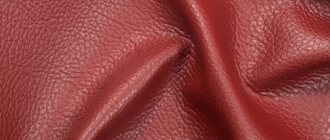Nylon - (poly-caproamide, nylon-6, polyamide 6) - is a thin, dense material from transparent to yellowish, the material has a slight characteristic shine. This is a very durable, wear-resistant and lightweight fabric, easy to care for, and does not change its properties when exposed to moisture.
“Nylon is a synthetic polyamide fiber obtained from petroleum, very strong: a nylon thread with a diameter of 0.1 millimeters can withstand a weight of 0.55 kg. The elasticity of nylon is much higher than silk. Abroad, synthetic fiber such as nylon is called peron and nylon. Nylon is produced in several grades; along with high strength, nylon fibers are characterized by resistance to abrasion and repeated deformation. The material does not absorb moisture and does not lose its strength when wet. When heated, its strength decreases and melting occurs at 215 degrees. Nylon is used to make ropes, fishing nets, fishing line, cord fabric, stockings and other household goods. Also, clothes are made from this material, which are much cheaper than clothes made from natural materials.” Wikipedia
Nylon material
Nylon is made by hydrogenating phenol. Typically, the oxidation formula of isopropylbenzene is used. Oxidation is made possible by two elements: propylene and benzene. The raw materials are petroleum products from which caprolactam is produced, from which polycaproamide is obtained. After this, fibers are produced from the products, which serve as the basis for the production of nylon.
Products made from nylon thread are characterized by high strength, reliability and are very durable. They adequately withstand intense loads, as well as various physical and mechanical impacts. Thanks to its excellent performance characteristics, nylon clothing will last for many years and will not change its presentable appearance.
Nylon production
The production process of producing nylon thread occurs in several stages. As a result of the polymerization of caprolactam, a thick gel is formed - this is an explosive substance; enterprises and factories that produce caprone require increased attention to safety. Polymerization is performed at a temperature of 270 degrees. To produce nylon threads, special equipment is used, through which the threads are pressed from the gel. The resulting substance is cooled, formed into a ribbon, crushed, and then the remaining water is evaporated and the granules are dried. The raw materials are melted until a liquid state is obtained, after which they are sent to molding machines, which produce threads according to specified parameters. After time, the threads turn into matter. Next, the threads are stretched industrially and sent to weavers.
The history of nylon
The history of nylon begins in 1938, in Germany Paul Schlak first synthesized polycaprolactam as a polymer to produce polyamide fiber, it was called perlon. Pal Schlak worked for IG Farben in Germany. In 1943, polycaprolactam production was established on an industrial scale. At that time, more than 3.5 tons per year were produced using phenol feedstock. Initially, coarse nylon threads were produced, which were used as artificial bristles. After a while, they began to produce parachute silk based on polycaprolactam, as well as cord for aircraft tires and towing ropes for gliders.
In the USSR in 1942, Rymashevskaya Yu.A., as well as Knunyants I.L. and Rogovin Z.A. made a discovery: they demonstrated the possibility of polymerizing caprolactam into a linear polymer; 5 years later they carried out work on the synthesis of fiber-forming polyamides, as a result of which they analyzed the conditions for the rearrangement of oximes into caprolactam. Thus, they identified the optimal conditions for the polymerization of lactams and the purification of polyamide from the monomer. The first production of polycaprolactam was opened in the USSR in 1948. It should be noted that fiber made from polyamide resins in Russia is called nylon and anide; in terms of their performance and technical characteristics, they practically do not differ from each other.
Since 1960, nylon has become more popular and is widely distributed both in Russia and in the world. This material is beginning to be produced on an industrial scale, and fabric made from aromatic heat-resistant polyamides is beginning to be used. Nylon thread is being produced from a polymer - polycaproamide. This was a real breakthrough in the production of this material; due to aminocaproic acid, which was the main component in the composition of this fiber, a substance was created that was called nylon.
Today, nylon is still relevant and in demand. Various household items, fishing nets, and fishing line are made from it. This material is especially in demand for sewing tights and stockings. These products are characterized by increased strength, reliability and incredible wear resistance. Thanks to its amazing performance properties, nylon thread is used for the production of clothing; its quality is not inferior to synthetic materials, but it is more accessible and has a low cost. In addition, nylon is used in a wide variety of production areas, for example, frames and car tires are made from this fabric. They are extremely reliable, durable, designed for intense loads and withstand physical and mechanical stress.
Advantages and disadvantages
In addition to the main characteristics of the fabric, the advantages include elasticity and low cost. It is noteworthy that the material does not rot and is resistant to chemical influences.
Flaws:
- Low environmental friendliness. This is due to the fact that the fabric is difficult to recycle.
- Burnability. In the sun, the material can quickly fade.
- Low heat resistance. The material will provide little protection from the cold.
- Lack of hygroscopicity. The fabric is not suitable for wearing in hot weather, as it has low hygienic properties. Such fabric will cause sweating and will not absorb excess moisture.
- The fabric is uncomfortable when worn on a naked body. With this method of wearing, many products can cause discomfort.
- Low resistance to acids.
This will be interesting to you All about Minky plush: what it means and what it consists of
Water drops on nylon
Thanks to its qualities, nylon is an indispensable material in everyday life. Despite some shortcomings, the release of this unique synthetic fabric has made human life much easier.
Types of nylon
To make nylon, various methods of weaving threads are used:
- linen;
- twill.
When the threads are weaved in plain linen, a strong and thin fabric is obtained. This type of nylon is widespread and is one of the most popular. Tights, stockings are sewn from it, fishing line and other products are made. This material is characterized by high strength, is very durable and can withstand physical and mechanical stress.
A distinctive feature of twill weave is the raised ribbed surface. This fabric is of high quality, incredible strength and is used in various fields of production.
Nylon thread differs in the method of dyeing:
- plain;
- with an image.
Plain threads are considered the most versatile and classic. Products made from these materials go well with almost any style and are in great demand.
Patterned nylon threads are produced in various colors: blue, red, green, yellow, as well as pastel colors and acid colors. Today, bright colors are also in demand; they emphasize individuality and skillfully transform the image.
Nylon threads are usually produced with a smooth surface, but there is another type - flocked material. It is made using a special technology, the surface of this material is velvety. It is very pleasant to the touch and symbolizes status and prosperity. This type of nylon is gaining popularity; it is characterized by high strength, is very durable and can easily withstand various physical and mechanical influences.
The advantage of nylon
- high strength and reliability (nylon thread with a diameter of 0.1 mm can withstand a load of 0.55 kg)
- increased resistance to abrasion (nylon retains its texture and attractive appearance throughout its entire service life);
- wear resistance (the material adequately withstands intense loads, various frictions and torsions);
- elasticity (dry nylon can stretch by 20-25%;
- synthetic fiber nylon has good water-repellent properties and practically does not get wet;
- this material is resistant to mold, moths, rotting and harmful microorganisms;
- easy to process and dye (thanks to this property, you can find nylon products in a wide variety of colors);
- light weight (approximately 20-60 g/sq.m.;
- nylon holds its shape perfectly, and after unscrewing it returns to its original state;
- not susceptible to extreme temperatures (can withstand temperatures as low as -70 degrees);
- resistance to alkalis and oxidizing agents;
- wide distribution and availability throughout the world;
- relatively low cost (this has a positive effect on the demand for nylon products);
- absolutely safe to use;
- hypoallergenic;
- practicality (nylon fiber does not require maintenance);
- durability (the material is able to withstand maximum loads; with timely care and careful treatment, nylon will last for many years).
Kapron: properties and application
In appearance, nylon is a material with a transparent to yellowish tint. The material has a slight shine. This is a thin but dense fabric.
Nylon cord thread
Nylon has properties such as strength, wear resistance and lightness. Dirt does not stick to it, does not change under the influence of water, is lightweight and easy to maintain. Items made from nylon fiber can be subjected to physical impact. For example, squeeze. But when scratched with a sharp object, the fiber is easily damaged.
Melting threads
The composition is not susceptible to the pathogenic effects of microorganisms. The fiber made from nylon does not absorb moisture, but when washed at too high temperatures it can lose its shape. The density of nylon may vary. The material cannot burn: it simply melts, forming a resinous substance.
Interesting fact. After graduation, it received the “title” of the strongest material, displacing silk from there.
Where is nylon used?
Nylon fabric is widely used and is common in the textile industry. Typically, the range of clothing produced is expanded through the production of mixed fabric. This is achieved by adding other materials to the main fabric tape, such as silk or viscose (raincoat version).
Nylon is a polymer used in the production of automobile and sporting goods, for example, the well-known tires. The filter fabrics required in production are also produced using nylon fabric.
You might be interested in what kind of material Lyosel is: natural or artificial
Nylon mesh
A large number of household goods needed are made from it. The use of nylon is reflected in the following products: cables, nets, fishing lines, ropes, curtains, tulle and medical consumables. Medical clothing and professional uniforms are often also produced thanks to nylon compounds. The most widespread are nylon tights, accessories, as well as elements in clothing where it is necessary to make any part of the body transparent.
Additional Information. Now curtains made of nylon fiber are not popular. The main role of the material in the production of curtains is reduced to external decoration.
How to care for nylon
Nylon is considered an undemanding material, however, certain care rules must be followed in order to extend the life of products made from this fabric. Before washing, you should read the label on the product, which contains basic care instructions.
How to wash nylon
You can wash nylon items by hand or in a machine. To do this, you need to set the washing machine to the “delicate” or “synthetic” mode. The recommended washing temperature should be 30-40 degrees. A good solution would be to use liquid detergents designed for synthetics. Do not bleach with chlorine or other aggressive detergents. They can have a negative impact on the fiber structure and change the presentable and original appearance. In addition, it is forbidden to set the spin cycle at high speeds of the machine, as this may have a negative effect on the material.
How to dry nylon
After washing, nylon products must be dried thoroughly. Drying clothes is best done flat. It is best to hang nylon products in the bathroom and allow excess moisture to drain, or wrap nylon clothing with a terry towel, which will absorb excess moisture. In addition, products must be dried away from artificial heat sources and battery radiators. It is also not recommended to leave things to dry on the balcony: prolonged exposure to sunlight can change the rich color and shape of the items. Nylon begins to turn yellow from ultraviolet rays, and also loses its high strength and becomes unusable. It is necessary to dry nylon items in a ventilated area, under natural conditions.
How to iron nylon
Products made from nylon most often do not require ironing; if small wrinkles appear, you can use an iron. To do this, set the iron to “synthetic” mode and iron the product. A good solution would be to use light lining fabric or gauze.
How to store nylon
Before sending nylon products for storage, items must be washed and dried thoroughly. You can store them in a closet using a fabric cover, away from the radiator and other heat sources. Storage on the balcony should be avoided; prolonged exposure to sunlight has a negative effect on the shape, structure and color of the fabric. Before sending for long-term storage, it is necessary to treat it with special agents against harmful bacteria and moths.
So, nylon is a universal and unique material that has the ideal combination of price and quality. Today, nylon thread is also in demand and is in great demand. Various products are made from it; this material is used in fishing, in the manufacture of fishing lines and nets. In addition, nylon is used for sewing tights and stockings - an invariable wardrobe of any woman. This material is easy to paint and very convenient to process. Reasonable price, excellent performance, high quality and use in everyday life are the defining advantages of this material.
Care
Let's look at how to care for products made from this synthetic material.
Washing is acceptable at temperatures up to 30 degrees. At higher temperatures, the fabric may lose some of its valuable qualities. If you wash by hand, then if necessary, the items can be pre-soaked in a soapy solution.
Nylon curtains tend to acquire a dirty gray tint over time . This happens due to the accumulation of dust in the material. Static electricity, characteristic of artificial fabric, perfectly “magnetizes” dust. Due to this problem, it is recommended to regularly clean dust from curtains with a vacuum cleaner with a special attachment.
On the video of tissue care that needs special care:
After washing, rinse thoroughly. Otherwise, particles of detergents stuck in the fibers will eventually lead to yellowing of the snow-white curtains.
Products are not wrung out in the machine. After washing, you need to remove them from the machine, let them drain, and then hang them on a line to dry. It is recommended to straighten it thoroughly before drying - in this case, the product will dry without creases. You can iron, but only at low temperatures.
If a textile product is saturated with an unpleasant odor, it is recommended to ventilate it in the air. After a couple of hours of such natural treatment, there will be no trace of unpleasant odors.

